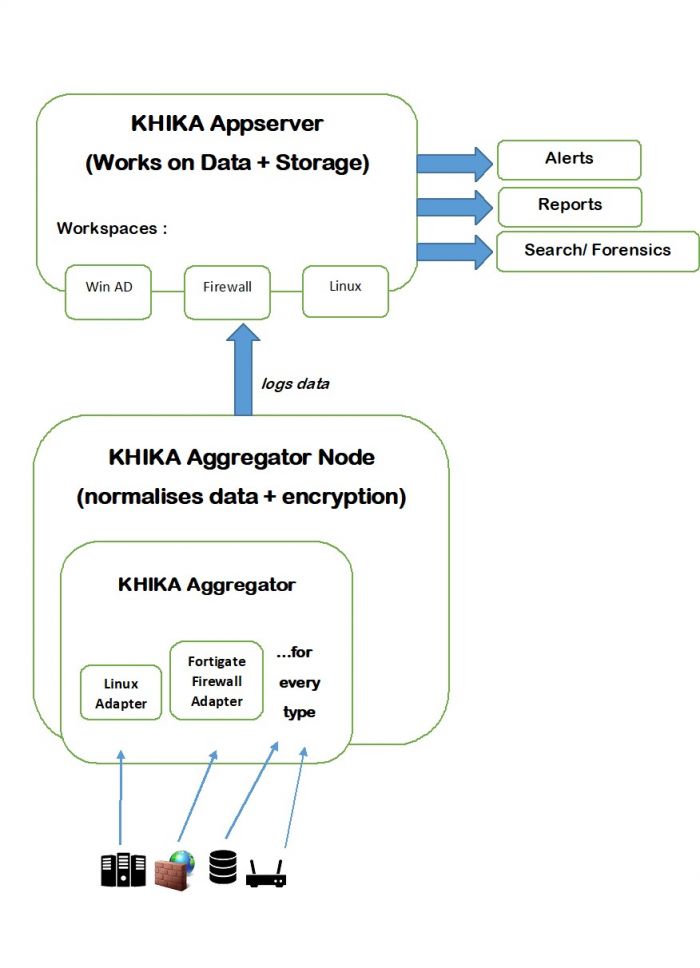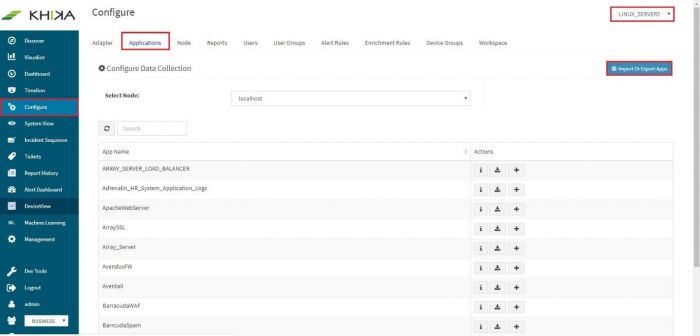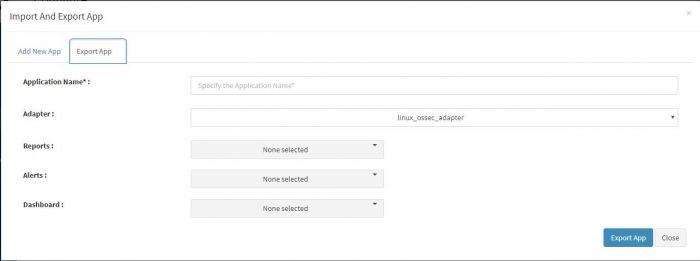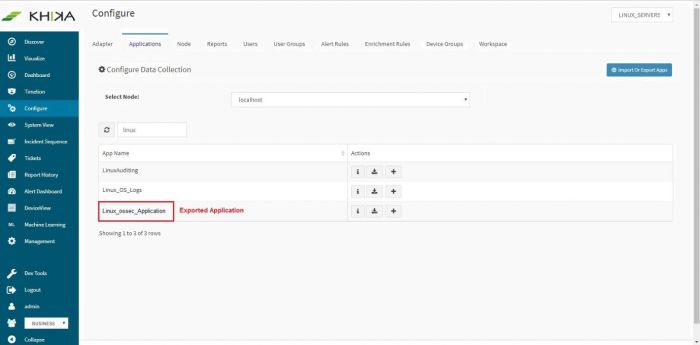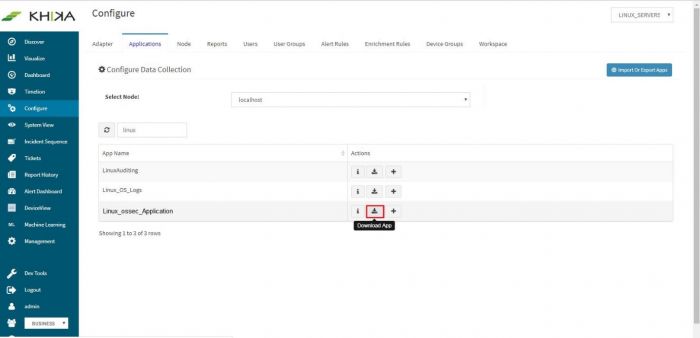Difference between revisions of "Getting Data into KHIKA"
| Line 318: | Line 318: | ||
*Login as "root" on the agent server | *Login as "root" on the agent server | ||
*Please note that firewall between the ossec agent and ossec server must be open for UDP protocol and 1514 port. | *Please note that firewall between the ossec agent and ossec server must be open for UDP protocol and 1514 port. | ||
| − | *In the OSSEC Agent installation directory, run manage-agent script from | + | *In the OSSEC Agent installation directory, run manage-agent script from /opt/ossec/bin/manage_agents |
| − | /opt/ossec/bin/manage_agents | ||
*You'll be presented with these options | *You'll be presented with these options | ||
| Line 330: | Line 329: | ||
*Restart the agent using command /opt/ossec/bin/ossec-control restart | *Restart the agent using command /opt/ossec/bin/ossec-control restart | ||
| + | |||
| + | === Insert unique OSSEC key in Windows OSSEC Agent === | ||
| + | |||
| + | |||
| + | Perform following simple steps on the Windows Agent | ||
| + | In the OSSEC Agent installation directory, run win32ui.exe to open-up a window as shown below – Run as Administrator. | ||
| + | |||
| + | |||
| + | ossec20 | ||
| + | Enter the IP Address of the KHIKA data aggregator or collector node and paste the copied key (generated by OSSEC server in the section 3.2.5 above) in the box against "Authentication key" and click Save. | ||
| + | From "Manage" drop-down, select "Restart" to restart the OSSEC Agent. Click on the Refresh button in the bottom next to Save. | ||
| + | ossec21 | ||
| + | Wait for a few minutes. Repeat above steps for all the agents to be added. | ||
| − | |||
=== Reload Configuration === | === Reload Configuration === | ||
| + | |||
| + | Login into the KHIKA portal. | ||
| + | Go to Configure | ||
| + | Select workspace, eg. WINDOWS_SERVERS | ||
| + | Go to Node Tab | ||
| + | Click Reload Config | ||
| + | |||
| + | |||
| + | ossec22 | ||
| + | |||
| + | |||
| + | This step restarts OSSEC Server. | ||
| + | Wait for a few minutes for server to restart. | ||
| + | |||
=== Verifying OSSEC data collection === | === Verifying OSSEC data collection === | ||
| + | |||
| + | |||
| + | Once the device is added successfully, we can check the data for this device on Discover screen. Select the appropriate index for the same. | ||
| + | |||
| + | |||
| + | ossec23 | ||
| + | |||
| + | |||
| + | In this screen enter search string in lower case – | ||
| + | tl_src_host : name_of_the_device_added_in_lower_case | ||
| + | |||
=== Troubleshooting === | === Troubleshooting === | ||
| + | |||
| + | |||
| + | If the data is not seen, wait for some time. If data still does no appear in the Discover tab, perform following steps. | ||
| + | Go to Agent Device | ||
| + | Go to ossec agent installation log directory (i.e. "/opt/ossec/logs") | ||
| + | Search for IP of the OSSEC Server in the log (i.e. ossec.log) and check if agent is connected to the server on its IP address. | ||
| + | If agent is not connected, you can restart the agent following command as "root" user. | ||
| + | /opt/ossec/bin/ossec-control restart | ||
| + | Check the log again for connection or any errors. | ||
| + | Make sure the firewall between agent device and OSSEC Server is opened for port UDP/1514 | ||
| + | Go to Discover page and search again to see if the data is coming. | ||
| + | If the data still does not appear in the search query, contact KHIKA Support. | ||
| + | |||
== Monitoring in KHIKA using Syslog forwarding == | == Monitoring in KHIKA using Syslog forwarding == | ||
Revision as of 09:07, 5 June 2019
Contents
- 1 Introduction
- 2 Data Flow and Components in KHIKA
- 3 KHIKA Apps
- 4 Importing an Application
- 5 Exporting an Application
- 6 Server monitoring in KHIKA using OSSEC
- 6.1 Installing OSSEC Agent for Linux
- 6.2 Installing OSSEC Agent for Windows
- 6.3 Configuring OSSEC Adapter in KHIKA
- 6.4 Adding the device in the Adaptor
- 6.5 Extract key from KHIKA OSSEC Server
- 6.6 Insert unique OSSEC key in Linux OSSEC Agent
- 6.7 Insert unique OSSEC key in Windows OSSEC Agent
- 6.8 Reload Configuration
- 6.9 Verifying OSSEC data collection
- 6.10 Troubleshooting
- 7 Monitoring in KHIKA using Syslog forwarding
Introduction
On completing the configuration steps from previous sections, we are ready to take in data from various devices into KHIKA. Network devices like Firewalls, Routers/Switches, Web proxies etc use Syslog protocol most of the times to forward the data to the KHIKA Aggregator. Linux and Windows Servers use OSSEC Agents and it’s Integration with KHIKA to forward the data. Integrating a device into KHIKA can be done in either of the ways and involves some basic steps :
- Pointing the device to be monitored to KHIKA data collector. This can be in different ways (explained separately in sections below for syslog and ossec)
- On the KHIKA end, making the device entry at the adaptor level.
For this step, on the KHIKA end, there are two ways of configuring the adaptor.
- Install an Application – This is the most recommended method to configure. KHIKA ships some standard applications and it is explained in the next section how to install an Application. This step includes adaptor configuration and adaptors don’t have to be added separately if you have installed relevant application
By Installing an application, you not only get an adaptor configured but also the relevant reports, dashboards and real time critical correlation alerts for this data source are configured in just a single click – by just installing the application.
- Configure an adaptor in the right workspace, within the KHIKA data collector. This step is required only when you have not installed an application. For example, in case of any specific web application logs in your organisation etc.
Data Flow and Components in KHIKA
Data is sent from the end node or data source to KHIKA data collector or Aggregator node locally within its network. Inside the Aggregator there are Adaptors, one for each data type. Each Adaptor receives data, parses and normalises it to KHIKA proprietary data format. This is sent to KHIKA application server where it is acted upon by the correlation engine, indexer and storage. This data is stored in the workspace meant for this data type or access. KHIKA creates output in the form of Reports and Dashboards, real time Alerts and Search. Following is a diagram for the same.
There can be multiple aggregator nodes collecting data from different locations and transferring data to a single KHIKA App server.
When we install an Application, as explained in the following section, the relevant adaptor is configured inside the correct aggregator, and the relevant alerts and reports are configured. There are different inbuilt applications each for standard data sources.
When we do not install an application, we have to add the relevant adaptor for that data type into its aggregator node. This step has to be done while the correct workspace is selected.
Workspace contains an Aggregator and an Adaptor.
A KHIKA user can have access to one or more workspaces. Before creating workspaces, it is important to think which users will have access to which workspaces. Design your workspaces with a clear view and understanding of the data. As a thumb rule, you must create a separate workspace for the data that needs restricted access. (Example:- If you don’t want your IT team to have access to your HR data, create a separate workspace for your HR data). Create different “User Groups”, one per “Workspace”. While creating the Workspace, carefully assign it to an appropriate “User Group”. Create Users and assign them to one or more “user Group/s” depending on the access requirements.
KHIKA Apps
Go to the Load a KHIKA App section for more.
Importing an Application
This feature is useful when there are newer KHIKA applications, which are not part of the current build. If there are data sources in your network for which there are newly developed KHIKA applications, KHIKA developers can export the KHIKA application (a .tar.gz file) Once you receive it, you can simply import it in a few easy steps. After importing, you can see it in the Applications list, install the imported application as explained in the section 3.1. Select Configure from the left panel. Select the appropriate workspace from the workspace dropdown on the top right. Go to the “Application” tab. Click on “Import Or Export Apps”
You will get a pop up as shown :
Click on “Choose App” button. This will open a browser windows to select the application’s exported file from your local machine, where you have saved it.
Select the file and click on “Upload” button. Click on Close button. We get a confirmation message in a pop up, after successful; upload and import of application.
The newly imported application is now visible in the applications list. When we enter “linux” in search, now we see the additional linux application.
Exporting an Application
Select Configure from the left panel. Select the appropriate workspace from the workspace dropdown on the top right. Go to the “Application” tab. Click on “Import Or Export Apps”
You will get a pop up as shown. Select “Export App” tab on the top.
Another pop up appears where we can enter and select details to be exported in the application.
The fields in this pop up are explained in the table below.
| Fields | Description |
|---|---|
| Application Name | Name of the exported application. You have to enter a new name for it. When you import this application, elsewhere it shall get imported with the new name you have given here. |
| Adapter | Select the relevant adaptor from the dropdown for the data type of this application. |
| Reports | The report dropdown has the names of all reports pre configured in this application. You can select which ones to export using checkboxes. Select one or more reports in this dropdown. Only those reports shall be available when this application is imported and installed elsewhere. |
| Alerts | Similar to report dropdown above, select the alerts you wish to export with this app. |
| Dashboard | Similar to report dropdown, select the dashboard names you wish to export. You can select as many dashboards as you wish, however a please note the reports selected in above dropdown. If there are any direct corresponding dashboards for these reports, you might want to select all those dashboards too. |
Click on “Export App” button.
Confirmation message appears on successful export.
This application, ready to be exported is now visible in the applications list.
Click on the download icon next to this application,
Now from our example screenshot, this is downloaded as “Linux_ossec_Application.tar.gz” on your local machine.
Server monitoring in KHIKA using OSSEC
This section is relevant if you are going to monitor your Windows or Linux servers using KHIKA App for Windows or Linux. KHIKA relies on OSSEC integration for monitoring Windows and Linux servers. Please read “Why KHIKA integrates closely with OSSEC?” in the About OSSEC section to know more about OSSEC and KHIKA Integration. There are 2 components in OSSEC monitoring.
- OSSEC Agent – Installed on each Linux / Windows server which we wish to pull data from.
- OSSEC Server – Present on KHIKA Data Aggregator or collector VM. If KHIKA is installed in your environment using the .ova KHIKA virtual appliance, then OSSEC server is already installed. You do not need additional steps for it.
In case you are not using the .ova file provided by KHIKA, OSSEC server should be separately installed. The installer is located in /opt/KHIKA/UTILS/OSSEC directory. The filename is “ossec_TL_Server.tar.gz”. In this case, the steps to install OSSEC Server on a Linux Machine are mentioned here.
The OSSEC agent and server are paired to each other using a unique key. Once they start talking to each other, Ossec agent then relays data to the Ossec server real time. Therefore the main steps to start getting data from a device are :
- Install Ossec agent on the Linux / Windows servers
- Configure OSSEC adaptor in KHIKA
- Add the Linux / Windows server details in KHIKA for respective Adaptor
- Extract a unique key for this device from KHIKA Adaptor
- Insert this key in the Ossec agent.
- Reload Configuration on Aggregator
Each of these steps is explained in detail in the further sections.
Installing OSSEC Agent for Linux
Download OSSEC agent for Linux from KHIKA install directory. The agent is shipped with KHIKA installer and is located on KHIKA Server in /opt/KHIKA/UTILS/OSSEC directory . For Linux you will need to select the Linux installer with filename ossec_TL_Agent.tar.gz. Copy the downloaded installer on your Linux server that you wish to monitor using KHIKA and run the installer with "root" credentials on the Server. Please Note : It is extremely important to install the OSSEC agent with "root" privileges as this agent reads the /var/log/security logs and some other important files. In order to read it successfully the ossec-agent process must be installed with "root" privileges. You will have to run following command as "root" user to install the Ossec Agent :- Remove / rename ossec directory if already exists on the agent. ie. our Linux server. mv /opt/ossec /opt/ossec_bak Go to the location where you have copied the Ossec agent installer mentioned above. Extract it using the following command tar –zxvf ossec_TL_Agent.tar.gz Then go to that directory using the cd command. You shall see a script by the name install.sh Then Run following command. "./install.sh"
ossec1
Now, add KHIKA Data Aggregator IP address (OSSEC server IP address) to point the OSSEC agent to the OSSEC server.
ossec2
NOTE :- You will have to repeat these steps on all the Linux Servers that you wish to monitor using KHIKA.
Installing OSSEC Agent for Windows
Download OSSEC agent for Microsoft Windows from KHIKA install directory. The agent is shipped with KHIKA installer and is located on KHIKA Server in /opt/KHIKA/UTILS/OSSEC directory. For Windows you will need to select the Windows installer with filename ossec-win32-agent.zip. This works for both 32-bit and 64-bit windows servers OS versions. Copy the downloaded installer on your Windows server (using winscp or your favourite scp client) and run installer with local "Admin" on the Server. Please Note : It is extremely important to install the OSSEC agent with admin privileges as this agent reads the security logs and in order to read it successfully, it has to be the local Admin. Select the installer file and Press "Run"
ossec3
Click Next
ossec4
Select "I Agree" and proceed
ossec5
Keep the default selection in the next window and click Next
ossec6
Enter the location to install the OSSEC agent on the local drive and let the installation complete
ossec7
After the installation is complete, verify that the OSSEC HIDS Service is successfully installed on your Windows Server. (Go to your Service Control Panel and check for OSSEC HIDS Service)
ossec8
NOTE :- You will have to repeat these steps on all the Windows Servers that you wish to monitor using KHIKA.
Configuring OSSEC Adapter in KHIKA
Refer this section only if you have not installed the relevant Application for your data type. (If you have installed KHIKA Application as mentioned in sectione 3.1, skip this section.) There is a list of inbuilt Adaptors in KHIKA, for as much as 200 different data sources and their multiple versions. You can see the entire list of Adaptors at /opt/KHIKA/Apps/Adapters/OssecArchiveLog For linux, we need an adaptor by script name “TLHookScriptArchiveMasterParser.py”. When you add it from the KHIKA gui, you can give it any name you want. The steps to configure the adaptor are the same for Windows and Linux. Linux adaptor is used in the example below. Go to Configure from the left panel. Select appropriate workspace from the workspace dropdown. In this case, Linux. Go to Adaptor tab. Click on “Add Adaptor” button. Following pop up appears. Enter adaptor details as mentioned.
ossec9
The fields in the pop up are explained
table
After entering details, click on Save. A success message pop up appears and the adaptor is seen in the adaptor tab now :
ossec10
Adding the device in the Adaptor
Next to this adaptor, click on the “Manage Devices” icon.
ossec11
Pop up appears for device details
ossec12
Click on “Add / Modify Device” tab. Another pop up appears for device details.
ossec13
Enter the expected device name. Also, in the field for IP address, enter “any”.
Please note : Always enter the IP Address as “any”. This is a safe and sure option to establish a connection with the server where we are suggesting ossec agent to use “any” of its configured IPs to be used to connect with the OSSEC Server. The device may have multiple NIC cards/IP addresses and unless we are sure of what IP will be used for connection, the connect will fail. Hence, use “any”
Select appropriate time zone of this device. In the “Node” field dropdown, select the name of the Aggregator or local data collector for this device.
Click on Submit. We get a success message and device is added successfully to this adaptor.
Finally, go to Workspace tab and click on “Apply Configuration” icon.
ossec14
Extract key from KHIKA OSSEC Server
Now the expected Linux server is added in the required adaptor. To see this device entry, click on “Manage Devices” icon next to the adaptor .
ossec15
A pop up with device details of the adaptor appears. Select “List of Devices” tab.
ossec16
Click on the “Get OSSEC Key” icon next to this device.
ossec17
ossec18
This is the unique key for this device created by the OSSEC server. Paste this key in the Ossec agent which is installed on this Linux server.
The above sections for configuring OSSEC adapter in KHIKA, adding device in adapter, extracting key from OSSEC server are same for Windows and Linux.
Insert unique OSSEC key in Linux OSSEC Agent
Perform following simple steps on the Linux Agent:
- Login as "root" on the agent server
- Please note that firewall between the ossec agent and ossec server must be open for UDP protocol and 1514 port.
- In the OSSEC Agent installation directory, run manage-agent script from /opt/ossec/bin/manage_agents
- You'll be presented with these options
ossec19
Select "i" to import the key (which we created in above section, on the Ossec server)
- Copy and paste the key generated on the server
- Restart the agent using command /opt/ossec/bin/ossec-control restart
Insert unique OSSEC key in Windows OSSEC Agent
Perform following simple steps on the Windows Agent In the OSSEC Agent installation directory, run win32ui.exe to open-up a window as shown below – Run as Administrator.
ossec20
Enter the IP Address of the KHIKA data aggregator or collector node and paste the copied key (generated by OSSEC server in the section 3.2.5 above) in the box against "Authentication key" and click Save.
From "Manage" drop-down, select "Restart" to restart the OSSEC Agent. Click on the Refresh button in the bottom next to Save.
ossec21
Wait for a few minutes. Repeat above steps for all the agents to be added.
Reload Configuration
Login into the KHIKA portal. Go to Configure Select workspace, eg. WINDOWS_SERVERS Go to Node Tab Click Reload Config
ossec22
This step restarts OSSEC Server.
Wait for a few minutes for server to restart.
Verifying OSSEC data collection
Once the device is added successfully, we can check the data for this device on Discover screen. Select the appropriate index for the same.
ossec23
In this screen enter search string in lower case –
tl_src_host : name_of_the_device_added_in_lower_case
Troubleshooting
If the data is not seen, wait for some time. If data still does no appear in the Discover tab, perform following steps. Go to Agent Device Go to ossec agent installation log directory (i.e. "/opt/ossec/logs") Search for IP of the OSSEC Server in the log (i.e. ossec.log) and check if agent is connected to the server on its IP address. If agent is not connected, you can restart the agent following command as "root" user. /opt/ossec/bin/ossec-control restart Check the log again for connection or any errors. Make sure the firewall between agent device and OSSEC Server is opened for port UDP/1514 Go to Discover page and search again to see if the data is coming. If the data still does not appear in the search query, contact KHIKA Support.
Monitoring in KHIKA using Syslog forwarding
Refer the next section for exploring your data in KHIKA
